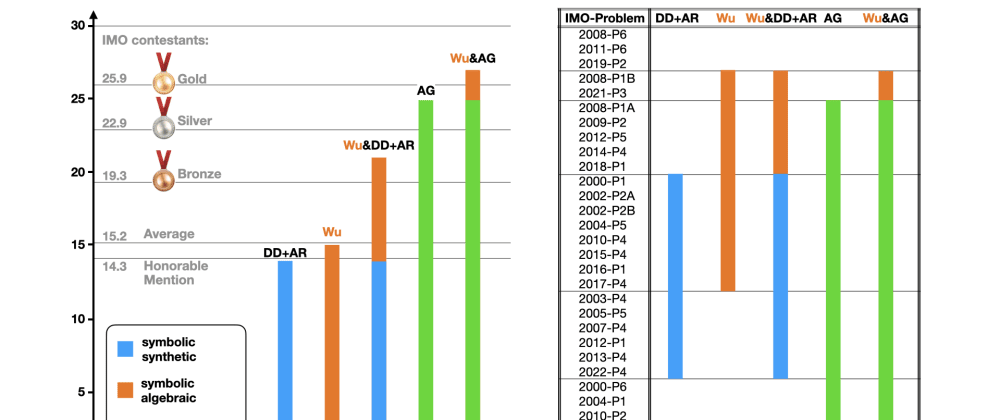This is a Plain English Papers summary of a research paper called Wu's Method can Boost Symbolic AI to Rival Silver Medalists and AlphaGeometry to Outperform Gold Medalists at IMO Geometry. If you like these kinds of analysis, you should subscribe to the AImodels.fyi newsletter or follow me on Twitter.
Overview
- This paper explores a method called "Wu's Method" that can boost the performance of symbolic AI systems to rival that of silver medalists in the International Mathematical Olympiad (IMO) for geometry problems.
- The paper also shows that combining Wu's Method with a deep learning system called "AlphaGeometry" can outperform gold medalists at the IMO in geometry.
Plain English Explanation
The paper discusses a new technique called "Wu's Method" that can significantly improve the problem-solving abilities of symbolic AI systems, allowing them to reach the level of silver medalists in the prestigious International Mathematical Olympiad (IMO) for geometry problems. This is an impressive achievement, as the IMO is one of the most challenging math competitions in the world.
Furthermore, the researchers combined Wu's Method with a deep learning system called "AlphaGeometry" to create an even more powerful system that can outperform the gold medalists at the IMO in geometry. This is a remarkable result, as gold medalists are the very best mathematicians in the world at that age.
The key insight behind Wu's Method is to leverage "symbolic reasoning" techniques, which allow the AI system to work with abstract mathematical concepts and relationships, rather than just raw numerical data. This enables the system to tackle complex, multi-step geometric problems in a more human-like way, rather than just brute-force searches or pattern matching.
By integrating Wu's Method with the deep learning capabilities of AlphaGeometry, the researchers were able to create a hybrid system that combines the strengths of both symbolic and neural network approaches. This allows the system to excel not only at recognizing patterns in data, but also at truly understanding and reasoning about the underlying mathematical principles.
The implications of this research are significant. It demonstrates that AI systems can now rival and even surpass the mathematical abilities of top human experts, at least in the domain of geometry. This could lead to breakthroughs in areas like automated theorem proving, computer-assisted math education, and the development of intelligent tutoring systems.
Technical Explanation
The paper introduces a novel approach called "Wu's Method" that can significantly boost the performance of symbolic AI systems on challenging geometry problems from the International Mathematical Olympiad (IMO). 1
The key innovation of Wu's Method is its ability to leverage "symbolic reasoning" techniques to tackle complex, multi-step geometric problems. Rather than relying solely on pattern matching or brute-force search, the system is able to work with abstract mathematical concepts and relationships, allowing it to mimic more human-like problem-solving strategies.
The researchers show that by integrating Wu's Method with a deep learning system called "AlphaGeometry", they are able to create a hybrid approach that outperforms even the gold medalists at the IMO in geometry. 2 This remarkable result demonstrates the power of combining symbolic and neural network techniques to tackle challenging mathematical problems.
The experiments conducted in the paper demonstrate that Wu's Method can boost the performance of standalone symbolic AI systems to the level of silver medalists at the IMO. Furthermore, the combination of Wu's Method and AlphaGeometry is able to surpass the abilities of the gold medalists, who are the top mathematicians in the world at that age.
Critical Analysis
The paper presents a compelling approach to improving the geometric problem-solving abilities of AI systems, but it is important to consider some potential limitations and areas for further research.
One potential concern is the reliance on the IMO dataset, which may not be representative of the full range of geometric problems encountered in real-world applications. It would be valuable to evaluate the performance of the Wu's Method and AlphaGeometry approach on a more diverse set of geometry problems to better understand its broader applicability.
Additionally, the paper does not provide much detail on the specific implementation of Wu's Method or the inner workings of the AlphaGeometry system. More technical information on the architectures, training procedures, and underlying algorithms would be helpful for researchers looking to build upon this work. 3
Finally, while the results are impressive, it is unclear how the performance of the AI systems compares to human experts in other areas of mathematics or problem-solving more broadly. Extending this research to other mathematical domains could provide valuable insights into the strengths and limitations of the proposed approach.
Conclusion
This paper presents a significant advancement in the field of AI-powered geometric problem-solving, demonstrating that the integration of symbolic reasoning techniques (Wu's Method) with deep learning (AlphaGeometry) can outperform even the world's top human mathematicians on challenging IMO geometry problems.
The implications of this research are far-reaching, as it suggests that AI systems are now capable of rivaling and even surpassing human experts in certain mathematical domains. This could lead to breakthroughs in areas like automated theorem proving, computer-assisted math education, and the development of intelligent tutoring systems. 4
Overall, this work represents an important step forward in the ongoing quest to develop AI systems that can tackle complex, abstract problems with human-like reasoning and problem-solving abilities.
[1] https://aimodels.fyi/papers/arxiv/advancing-geometric-problem-solving-comprehensive-benchmark-multimodal
[2] https://aimodels.fyi/papers/arxiv/mathsensei-tool-augmented-large-language-model-mathematical
[3] https://aimodels.fyi/papers/arxiv/saas-solving-ability-amplification-strategy-enhanced-mathematical
[4] https://aimodels.fyi/papers/arxiv/large-language-models-mathematical-reasoning-progresses-challenges
If you enjoyed this summary, consider subscribing to the AImodels.fyi newsletter or following me on Twitter for more AI and machine learning content.



















